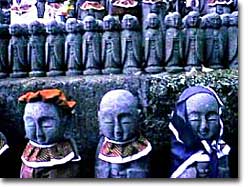57d. Roe v. Wade and Its Impact

Pope John Paul II was a leader in the pro-life movement. During his landmark 1998 visit to Cuba, he criticized the island's legalized abortion policies.
No topic related to the feminist movement has aroused such passion and controversy as much as the right to an abortion. In the 1960s, there was no federal law regulating abortions, and many states had banned the practice entirely, except when the life of the mother was endangered.
Women's groups argued that illegality led many women to seek black market abortions by unlicensed physicians or to perform the procedure on themselves. As a result, several states such as California and New York began to legitimize abortions. With no definitive ruling from the federal government, women's groups sought the opinion of the United States Supreme Court.
The battle began in Texas, which outlawed any type of abortion unless a doctor determined that the mother's life was in danger. The anonymous Jane Roe challenged the Texas law, and the case slowly made its way to the highest court in the land.
After two years of hearing evidence, the Court invalidated the Texas law by a 7-2 vote. Using the same reasoning as the Griswold v. Connecticut decision, the majority of the justices maintained that a right to privacy was implied by the Ninth and Fourteenth Amendments. No state could restrict abortions during the first three months, or trimester, of a pregnancy.
States were permitted to adopt restrictive laws in accordance with respecting the mother's health during the second trimester. The practice could be banned outright during the third trimester. Any state law that conflicted with this ruling was automatically overturned.
Women's groups were ecstatic. But immediately an opposition emerged. The Roman Catholic Church had long criticized abortion as a form of infanticide. Many fundamentalist Protestant ministers joined the outcry. The National Right to Life Committee formed with the explicit goal of reversing Roe v. Wade.

Religious traditions throughout the world have very different views on unborn children. In Japan, the Bodhisattva Jizo is the guardian of unborn children and expectant mothers. Legend has it that when babies die, they are sent to the underworld for causing their parent's great suffering. Jizo rescues the children from that punishment.
The issue is fundamentally thorny because it involves basic faiths. Those who believe life begins at conception feel that the unborn child deserves the same legal protections as an adult. Ending such a life is equivalent to murder to those who subscribe to this belief. Others argue that life begins at birth, and that laws restricting abortion interfere with the right of a woman to decide what is in her own best interests. Opponents of abortion use the label "pro-life" to define their cause. Supporters of Roe v. Wade identify themselves as "pro-choice."
Since 1973, the battle has raged. Pro-life groups began to lobby their Senators and Representatives to propose a Right-to-Life Amendment to the Constitution. Although introduced in Congress, the measure has never received the necessary support. Pro-choice groups such as the National Abortion Rights Action League fear that a slow erosion of abortion rights has taken place since Roe v. Wade.
The Hyde Amendment of 1976 prohibits the use of federal Medicaid funds to be used for abortions. Later Court decisions such as Planned Parenthood v. Casey(1992) have upheld the right of states to impose waiting periods and parental notification requirements. President George Bush imposed a "gag rule" that prohibited workers in federally funded clinics from even mentioning abortion as an option with their patients. Bill Clinton promptly ended the gag rule in 1993.
Planned Parenthood clinics have become local battlegrounds over the abortion controversy. Since Planned Parenthood prides itself in providing safe, inexpensive abortions, protesters regularly picket outside their offices. Several Planned Parenthood sites have even been bombed by antiabortion extremists.
The Supreme Court issued several important abortion rulings after Roe v. Wade, notably Planned Parenthood of Southeastern Pennsylvania v. Casey (1992), the case many thought would overturn Roe. While the conservative Court did uphold the constitutionality of some elements of the PA law restricting abortion that formed the basis of the case, it declined to overturn Roe, as some hoped and others feared it would.
Roe v. Wade was finally overturned by Dobbs v. Jackson Women's Health Organization (2022). This ruling turned full authority concerning abortion to the individual states. Some states had already passed "trigger bans," outlawing abortion in almost all cases, that went into effect immediately after the Dobbs decision. Other states, starting with Indiana, passed new legislation restricting abortion.
Some state supreme courts have ruled that their state constitutions include an implicit right to an abortion. In response, abortion opponents have sought to amend state constitutions to explicitly allow the passage of legislation restricting abortion. Supporters of abortion rights have likewise mobilized to amend state constitutions to explicitly guarantee the right to an abortion.
The battleground in this still heated debate has shifted from the U.S. Supreme Court to the legislatures and the state courts in each of the states. Until the Supreme Court issues a ruling with the broad implications of Roe or Dobbs, a woman's right to an abortion in the U.S. is now very much a question of geography.






